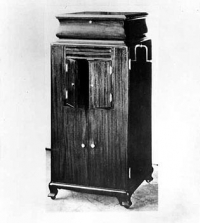Victrola Model XVI
Copy The Victor Talking Machine Company, founded in 1901 by Emil Berliner and Eldridge R. Johnson, introduced the Victrola at a price of $200. Unlike previous phonographs, which were toy-like turntables with a large speaker horn to amplify the sound, this was housed in an elegant wood cabinet in several contemporary (for the time) furniture styles. The speaker horn and turntable mechanism were totally concealed, and there were convenient storage compartments for records. This Victrola design, by Johnson, and in particular a refined version of 1907, transformed the phonograph into a popular household item, and set the pattern of wood cabinetry enclosures later imitated by radios and television sets well into the 1950s. Berliner (1851-1929) had in 1888 invented the first flat rubber disc system, an improvement over Thomas A. Edison's original 1877 cylinder system, and incorporated it into his 1896 Gramophone. Johnson, also an inventor, improved the sound quality of Berliner's system with a spring-driven motor. Together, Berliner and Johnson formed the Victor Talking Machine Company in 1901, which was acquired by RCA in 1929.
